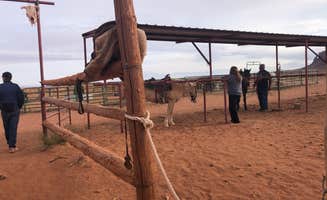Dispersed camping options near Glen Canyon National Recreation Area expand beyond Burr Road for equestrian visitors. The area sits in Utah's high desert at elevations ranging from 4,000 to 6,000 feet with dramatic temperature variations between seasons. The Colorado Plateau's porous sandstone terrain creates challenging conditions for both vehicles and horses, especially after rain when dirt roads become impassable.
What to do
Trail riding from campsites: Several dispersed areas provide direct access to backcountry riding trails. Durffey Mesa connects riders with routes through Grand Staircase-Escalante. A camper reports it's a "good location to have a few group camp next to small Butte" with coordinates at "37.84858,-111.37018," slightly different than what some maps show.
Visit nearby attractions: Sleeping Bear Campground offers primitive sites with riding access. As one visitor noted, "Amazing views at sunset, quiet, and we saw horses around in the morning. Wonderful." The campground provides basic amenities while serving as a hub for exploring lesser-known monuments.
Explore backcountry roads: Many horse-friendly camping areas connect to four-wheel drive roads suitable for day rides. Near Monument Valley KOA, "This area is so desolate it's breathtaking," making it ideal for experienced riders seeking solitude. Trails range from easy valley floors to technical rocky terrain.
What campers like
Natural quiet: Camping away from established campgrounds provides significantly more solitude. At Burr Road Dispersed Camp, one visitor described it as "Campsite with 4 wheel drive access high clearance vehicle. Okay for pets not near the edge of canyon. Little bit of cell service. Little shelter of trees."
Dark skies: The minimal light pollution makes stargazing exceptional. Antelope Hogan notes, "The property is exclusive and off the grid. Don't forget to look up at the night sky, beautiful star lite." Most dispersed sites have unobstructed views of the night sky without competing light sources.
Wildlife viewing: Many campsites offer opportunities to observe free-ranging horses and other wildlife. As one Sleeping Bear visitor mentioned, "We were the only ones camping here that night and could choose our spot. Access is through an easy dirt road. Amazing views at sunset, quiet, and we saw horses around in the morning."
What you should know
Road conditions: Access roads to horse-friendly camping areas vary significantly by season and recent weather. Durffey Mesa sits at the end of "a big gravel looking parking lot. Just below two big rock formations and beside a dry creek bed," requiring careful navigation during wet conditions.
Limited amenities: Most horse camping locations lack dedicated facilities. Prepare to be self-sufficient with water, feed, and waste management systems. The campground at Sleeping Bear has "No shower, dirty toilets, no water, no trash bins" but compensates with "25 dollars per night, viewpoint is amazing, quiet."
Land management rules: Different areas have specific regulations regarding horse use, campfires, and waste disposal. Rules can change seasonally, particularly regarding fire restrictions during dry months. Always check current regulations before arrival.
Tips for camping with families
Safety planning: When camping with horses and children, establish clear boundaries. At Escalante Cabins & R.V. Park, which serves as a good basecamp between dispersed camping trips, visitors note the "road to the gulches was rough and our truck got a flat. Be prepared with lots of water, food and full gas tank in case you run into trouble on the road. No signal on the road to the gulches."
Site selection: Choose camping areas with natural barriers or terrain features that help contain horses while providing safe play spaces for children. Look for "sites that are gravel, fairly level and very large. Plenty of room for trailer and truck in site," as mentioned about Escalante Cabins.
Weather preparation: Temperature swings can be extreme, requiring adaptable clothing and shelter systems. One camper at Monument Valley noted, "We watched the most beautiful sunset over the landscape" but also mentioned that "wild dogs" in the area "bark at night" – something to consider with children.
Tips from RVers
Trailer access: Horse trailers with living quarters require careful route planning. Most dispersed equestrian camping spots near Glen Canyon have limited turnaround space. One visitor to Antelope Hogan Bed and Breakfast mentioned it's "big-rig friendly" despite being "exclusive and off the grid."
Seasonal considerations: Winter camping requires additional preparations for both humans and horses. One RVer at Escalante noted, "We arrived here in a winter storm and were very happy to find an open RV park as most campgrounds and other RV parks were closed for the season... Lots of snow fell during the afternoon/evening but maintenance person plowed in the morning."
Water management: No dispersed horse campgrounds near Glen Canyon National Recreation Area provide water hookups. Plan to haul adequate water for both human consumption and horse needs, particularly during hot months when horses may require 15+ gallons daily per animal.



